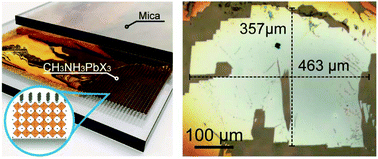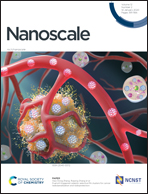Liquid-phase growth and optoelectronic properties of two-dimensional hybrid perovskites CH3NH3PbX3 (X = Cl, Br, I)†
Abstract
The hybrid perovskite CH3NH3PbX3 (X = Cl, Br, I) is a promising material for developing novel optoelectronic devices. Due to its intrinsic non-layered crystal structure, it remains challenging to synthesize two-dimensional (2D) single-crystalline CH3NH3PbX3 with nanoscale thickness. Here, we report a bottom-up approach to fabricate large CH3NH3PbX3 2D crystals via liquid-phase growth on a mica substrate. The strong potassium-halogen interactions at the perovskite/mica interface decrease the interface energy, driving the striking in-plane growth of the perovskite. The grown 2D CH3NH3PbBr3 crystal was characterized as 8 nm in thickness and hundreds of micrometers in lateral size. Weak exciton binding energy was crucial for improving the photoelectric performance of 2D CH3NH3PbBr3. A visible-light photodetector with a metal/insulator/perovskite configuration was finally achieved with a photoresponsivity of 126 A W−1 and a bandwidth exceeding 80 kHz. Our work proves that the liquid-phase growth on mica is a controllable method to grow 2D hybrid CH3NH3PbX3 perovskites, which can facilitate both device applications and fundamental investigations.



 Please wait while we load your content...
Please wait while we load your content...